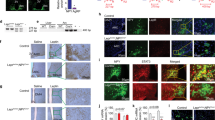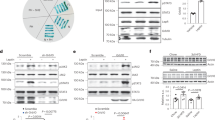Abstract
Bone remodeling, the function affected in osteoporosis, the most common of bone diseases, comprises two phases: bone formation by matrix-producing osteoblasts1 and bone resorption by osteoclasts2. The demonstration that the anorexigenic hormone leptin3,4,5 inhibits bone formation through a hypothalamic relay6,7 suggests that other molecules that affect energy metabolism in the hypothalamus could also modulate bone mass. Neuromedin U (NMU) is an anorexigenic neuropeptide that acts independently of leptin through poorly defined mechanisms8,9. Here we show that Nmu-deficient (Nmu−/−) mice have high bone mass owing to an increase in bone formation; this is more prominent in male mice than female mice. Physiological and cell-based assays indicate that NMU acts in the central nervous system, rather than directly on bone cells, to regulate bone remodeling. Notably, leptin- or sympathetic nervous system–mediated inhibition of bone formation6,7 was abolished in Nmu−/− mice, which show an altered bone expression of molecular clock genes (mediators of the inhibition of bone formation by leptin). Moreover, treatment of wild-type mice with a natural agonist for the NMU receptor decreased bone mass. Collectively, these results suggest that NMU may be the first central mediator of leptin-dependent regulation of bone mass identified to date. Given the existence of inhibitors and activators of NMU action10, our results may influence the treatment of diseases involving low bone mass, such as osteoporosis.
This is a preview of subscription content, access via your institution
Access options
Subscribe to this journal
Receive 12 print issues and online access
$209.00 per year
only $17.42 per issue
Buy this article
- Purchase on Springer Link
- Instant access to full article PDF
Prices may be subject to local taxes which are calculated during checkout




Similar content being viewed by others
References
Rodan, G.A. & Martin, T.J. Therapeutic approaches to bone diseases. Science 289, 1508–1514 (2000).
Teitelbaum, S.L. & Ross, F.P. Genetic regulation of osteoclast development and function. Nat. Rev. Genet. 4, 638–649 (2003).
Saper, C.B., Chou, T.C. & Elmquist, J.K. The need to feed: homeostatic and hedonic control of eating. Neuron 36, 199–211 (2002).
Ahima, R.S. & Flier, J.S. Leptin. Annu. Rev. Physiol. 62, 413–437 (2000).
Spiegelman, B.M. & Flier, J.S. Obesity and the regulation of energy balance. Cell 104, 531–543 (2001).
Ducy, P. et al. Leptin inhibits bone formation through a hypothalamic relay: a central control of bone mass. Cell 100, 197–207 (2000).
Takeda, S. et al. Leptin regulates bone formation via the sympathetic nervous system. Cell 111, 305–317 (2002).
Hanada, R. et al. Neuromedin U has a novel anorexigenic effect independent of the leptin signaling pathway. Nat. Med. 10, 1067–1073 (2004).
Brighton, P.J., Szekeres, P.G. & Willars, G.B. Neuromedin U and its receptors: structure, function, and physiological roles. Pharmacol. Rev. 56, 231–248 (2004).
Fang, L., Zhang, M., Li, C., Dong, S. & Hu, Y. Chemical genetic analysis reveals the effects of NMU2R on the expression of peptide hormones. Neurosci. Lett. 404, 148–153 (2006).
Riggs, B.L., Khosla, S. & Melton, L.J. 3rd . A unitary model for involutional osteoporosis: estrogen deficiency causes both type I and type II osteoporosis in postmenopausal women and contributes to bone loss in aging men. J. Bone Miner. Res. 13, 763–773 (1998).
Karsenty, G. & Wagner, E.F. Reaching a genetic and molecular understanding of skeletal development. Dev. Cell 2, 389–406 (2002).
Harada, S. & Rodan, G.A. Control of osteoblast function and regulation of bone mass. Nature 423, 349–355 (2003).
Idris, A.I. et al. Regulation of bone mass, bone loss and osteoclast activity by cannabinoid receptors. Nat. Med. 11, 774–779 (2005).
Abe, E. et al. TSH is a negative regulator of skeletal remodeling. Cell 115, 151–162 (2003).
Elefteriou, F. et al. Leptin regulation of bone resorption by the sympathetic nervous system and CART. Nature 434, 514–520 (2005).
Fu, L., Patel, M.S., Bradley, A., Wagner, E.F. & Karsenty, G. The molecular clock mediates leptin-regulated bone formation. Cell 122, 803–815 (2005).
Howard, A.D. et al. Identification of receptors for neuromedin U and its role in feeding. Nature 406, 70–74 (2000).
Wren, A.M. et al. Hypothalamic actions of neuromedin U. Endocrinology 143, 4227–4234 (2002).
Parfitt, A.M. The physiological and clinical significance of bone histomorphometric data. in Bone Histomorphometry (ed. Recker, R.R.) 143–223 (CRC Press, Boca Raton, FL, 1983).
Chu, C. et al. Cardiovascular actions of central neuromedin U in conscious rats. Regul. Pept. 105, 29–34 (2002).
Ahn, J.D., Dubern, B., Lubrano-Berthelier, C., Clement, K. & Karsenty, G. Cart overexpression is the only identifiable cause of high bone mass in melanocortin 4 receptor deficiency. Endocrinology 147, 3196–3202 (2006).
Kalinova, J., Triska, J. & Vrchotova, N. Distribution of vitamin E, squalene, epicatechin, and rutin in common buckwheat plants (Fagopyrum esculentum Moench). J. Agric. Food Chem. 54, 5330–5335 (2006).
Zeng, H. et al. Neuromedin U receptor 2–deficient mice display differential responses in sensory perception, stress, and feeding. Mol. Cell. Biol. 26, 9352–9363 (2006).
Elias, C.F. et al. Leptin differentially regulates NPY and POMC neurons projecting to the lateral hypothalamic area. Neuron 23, 775–786 (1999).
Graham, E.S. et al. Neuromedin U and Neuromedin U receptor-2 expression in the mouse and rat hypothalamus: effects of nutritional status. J. Neurochem. 87, 1165–1173 (2003).
Paxinos, G. & Franklin, K. The Mouse Brain in Stereotaxic Coordinates 2nd edn. (Academic Press, San Diego, 2001).
Acknowledgements
We thank G. Karsenty, M. Patel and P. Ducy for critical review of the manuscript and for helpful discussions; K. Nakao, M. Noda, T. Matsumoto and S. Ito for insightful suggestions; P. Barrett (Rowett Research Institute, UK) for providing a plasmid for the Cartpt probe; and J. Chen, M. Starbuck, S. Sunamura, H. Murayama, H. Yamato, and M. Kajiwara for technical assistance. This work was supported by grant-in-aid for scientific research from the Japan Society for the Promotion of Science, a grant for the 21st Century Center of Excellence program from the Ministry of Education, Culture, Sports, Science, and Technology of Japan, Ono Medical Research Foundation, Yamanouchi Foundation for Research on Metabolic Disorders, Kanae Foundation for the Promotion of the Medical Science and the Program for Promotion of Fundamental Studies in Health Sciences of the National Institute of Biomedical Innovation of Japan.
Author information
Authors and Affiliations
Contributions
S. Sato conducted most of the experiments. K. Kangawa and M. Kojima generated Nmu−/− mice. R. Hanada and T. Ida conducted in vitro experiments. S. Fukumoto, Y. Takeuchi and T. Fujita contributed by conducting dual X-ray absorptiometry analyses and providing suggestions on the project. M. Iwasaki prepared the constructs. A. Kimura performed i.c.v. infusion experiments. H. Inose conducted μCT analyses. T. Matsumoto and S. Kato conducted histological analyses for brain tissue. T. Abe and M. Mieda performed in situ hybridization analysis. S. Takeda and K. Shinomiya designed the project. S. Takeda supervised the project and wrote most of the manuscript.
Corresponding author
Supplementary information
Supplementary Figures
Supplementary Figs. 1–7 (PDF 5011 kb)
Rights and permissions
About this article
Cite this article
Sato, S., Hanada, R., Kimura, A. et al. Central control of bone remodeling by neuromedin U. Nat Med 13, 1234–1240 (2007). https://doi.org/10.1038/nm1640
Received:
Accepted:
Published:
Issue Date:
DOI: https://doi.org/10.1038/nm1640
This article is cited by
-
Three-dimensional visualization of neural networks inside bone by Osteo-DISCO protocol and alteration of bone remodeling by surgical nerve ablation
Scientific Reports (2023)
-
SIRT6-PAI-1 axis is a promising therapeutic target in aging-related bone metabolic disruption
Scientific Reports (2023)
-
Psychological stress: neuroimmune roles in periodontal disease
Odontology (2023)
-
Low-dose IL-34 has no effect on osteoclastogenesis but promotes osteogenesis of hBMSCs partly via activation of the PI3K/AKT and ERK signaling pathways
Stem Cell Research & Therapy (2021)
-
Neuronal Cell Adhesion Molecule 1 Regulates Leptin Sensitivity and Bone Mass
Calcified Tissue International (2018)



